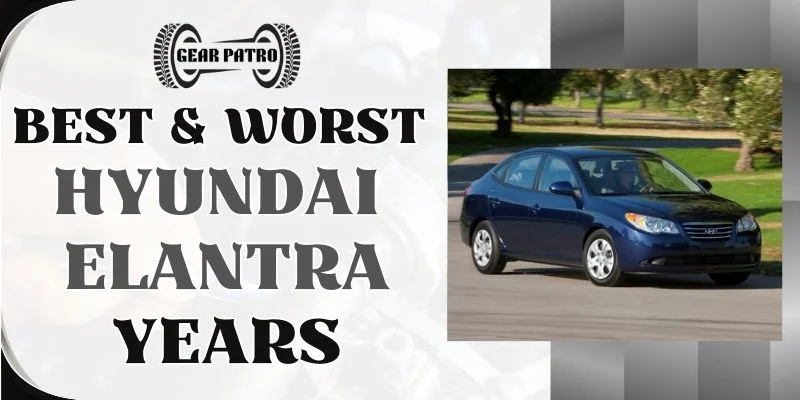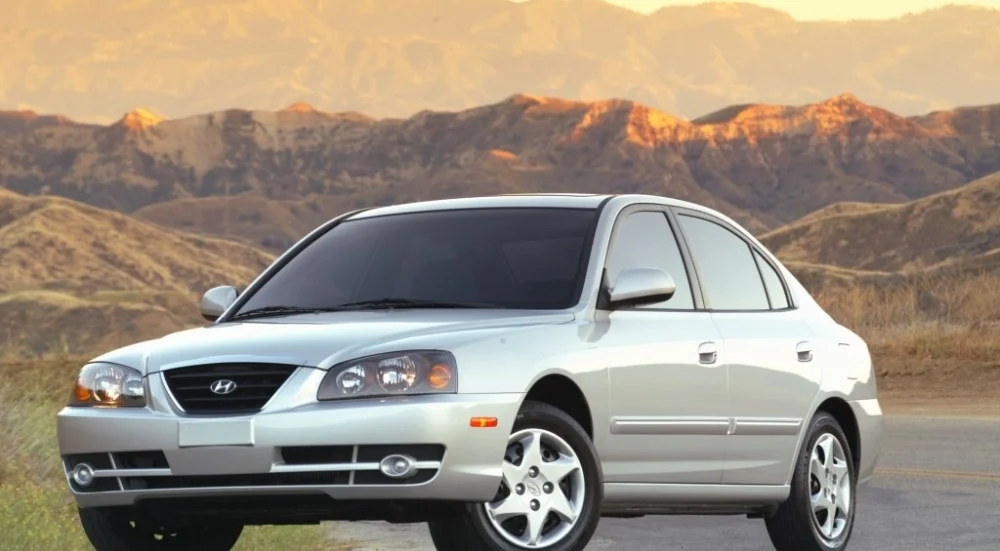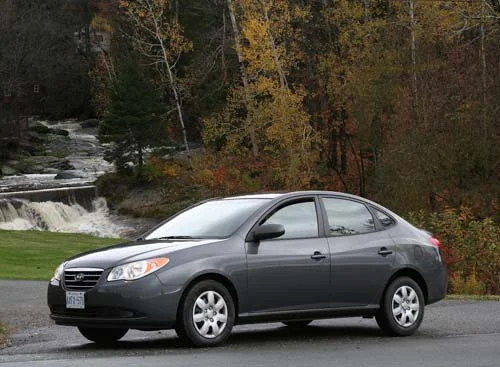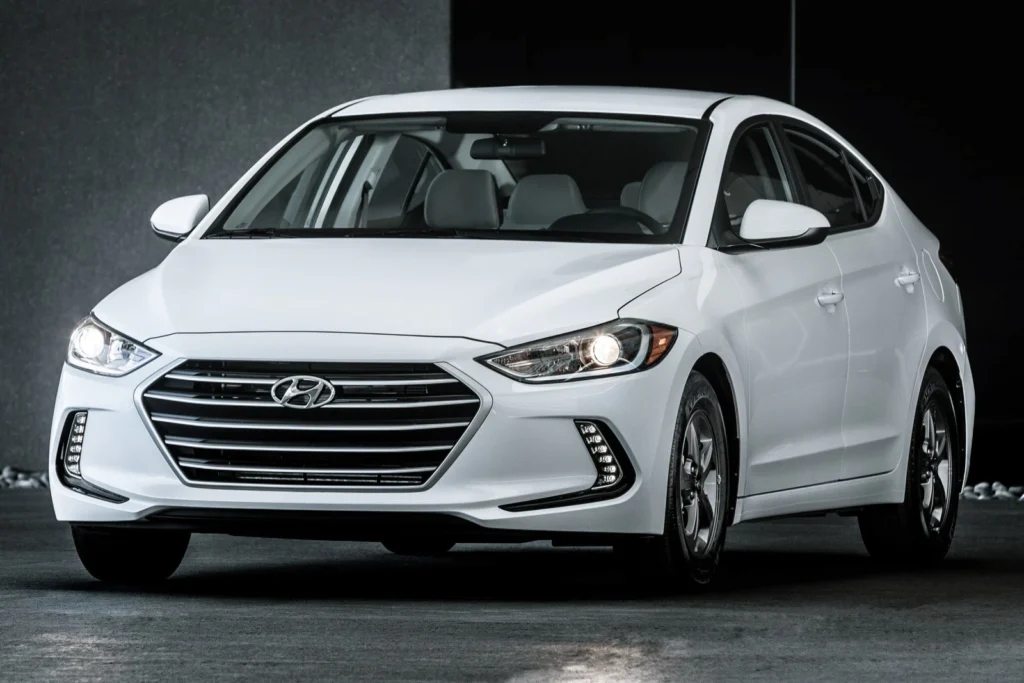From 2001 to the current model, we’ve reviewed every Hyundai Elantra and categorized the best and worst years.
We will break down consumer reviews, owner satisfaction, and reliability in this ultimate guide to Hyundai Elantra model years.
In order to analyze each generation to highlight its strengths and weaknesses, we sourced extensive research from reliable sources, including NHTSA, Kelley Blue Book, and others.

By the end of this article, you will have gained a thorough understanding of every Hyundai Elantra model year, as well as their unique problems and features.
Let’s get started.
Hyundai Elantra Generations
In 1990, Hyundai introduced the Elantra, a compact vehicle with an affordable price tag that became a major player in the automotive world.
Our analysis will be limited to models post-2000 because the first and second generations are older and there aren’t enough data to assess them comprehensively.
From 2001 onward, the Hyundai Elantra has been manufactured in the following generations:
| Generation | Years |
| 3rd generation (XD) | 2001-2006 |
| 4th generation (HD) | 2007-2010 |
| 5th generation (MD/UD) | 2011-2016 |
| 6th generation (AD) | 2017-2020 |
| 7th generation (CN7) | 2021-Present |
Potential buyers must recognize the generational differences in driving experience, as it can have a significant impact on their overall driving experience and may even influence their purchase decision.
Best & Worst Hyundai Tucson Years | Years To Avoid
Best & Worst Hyundai Santa Fe Years | Years To Avoid
Hyundai Elantra Best, Neutral, and Worst Years
The factors we consider in our comprehensive ranking and categorization of Hyundai Elantra’s model years are numerous. Factors such as:
On the basis of our extensive research, we have categorized each Hyundai Elantra model year as best, neutral, or worst.
| Generation | Best Years | Neutral Years | Worst Years |
| 3rd generation (XD) | 2005 2006 | 20032004 | 2001 2002 |
| 4th generation (HD) | 2007 2008 | N/A | 2009 2010 |
| 5th generation (MD/UD) | 2014 2015 2016 | N/A | 2011 2012 2013 |
| 6th generation (AD) | 2018 2019 2020 | N/A | 2017 |
| 7th generation (CN7) | 2022 2023 | N/A | 2021 |
A Neutral Year is a model year that does not stand out for its excellence when compared with other years or significantly underperforms when compared to other years. A balanced performance is evident during these years, without any major pitfalls or standout features.
There is no doubt that some of these factors contribute negatively to the overall assessment, but it is important to keep this in mind. It is common for a vehicle to have more NHTSA recalls or complaints, for example, when reliability issues are present.
Taking a look at the best, neutral, and worst years, let’s see what they have in common.
Best & Worst Years for Hyundai Elantra 3rd Generation (2001-2006)
In 2001, Hyundai Elantra’s third generation was introduced, paving the way for the company’s future.

Despite being known for producing budget vehicles, Hyundai has worked hard to make cars that are reliable, well-designed, and equipped with modern features, while remaining economically viable.
The Best Years: 2005, 2006
Elantra had been extensively refined by Hyundai by 2005, ensuring competitiveness in its segment. The 2.0L DOHC engine that powered these models was renowned for its efficiency and longevity.
This model was available with either a 4-speed automatic transmission or a 5-speed manual transmission, ensuring both efficiency and performance. Each trim level had something to appeal to everyone, including the feature-rich GLS and sporty GT.
Its leather interior and firmer suspension setup enhanced handling and provided a more dynamic driving experience. During these years, Hyundai focused on technological advancements and safety improvements.
Airbags and antilock brakes were standardized by the brand, along with advanced in-car entertainment systems.
The Neutral Years: 2003, 2004
During the early years of the generation, the 2003 and 2004 models served as a bridge, linking the early challenges with later refinements. In this case, rusty front lower arms were the main concern, causing suspension problems.
With their 2.0L DOHC engines, they continued to offer dependable performance and saw incremental improvements compared to the predecessors. A balance between cost and features was provided by these models, available mostly in the GLS trim.
As a result of these technological advances, Hyundai increased the Elantra’s technological footprint during these years. In the early models, safety was becoming increasingly important, but not with the comprehensiveness of later models.
The Worst Years: 2001, 2002
There were several problems with the 2001 and 2002 Elantras. Airbags and suspension systems were among the most common complaints they received from NHTSA.
In 2001, frequent reports of intermittent airbag illumination were reported by owners. Multiple recalls were subsequently issued due to airbag failures. There were also numerous suspension and brake problems, as corrosion posed a serious threat.
A significant amount of corrosion, particularly on the lower arms of the suspension, adversely affected the ride quality and posed a safety threat to the vehicle. As a result of the 2002 model, new concerns have been raised about the service brakes.
The 2001 and 2002 Elantra models are widely regarded as the least desirable of this generation because of these recalls, safety issues, and a number of owner complaints.
Hyundai Elantra recalls and complaints from 2001, 2002, and 2003 can be found at the NHTSA website.
Best & Worst Years for Hyundai Elantra 4th Generation (2007-2010)
The Elantra 4th generation redefined Hyundai’s position in the compact car market segment as it transitioned into its fourth generation.

With the development of the Elantra, the design matured, its features evolved, and global automotive trends were incorporated throughout the line.
The Best Years: 2007, 2008
Hyundai’s quest for excellence with the Elantra reached a zenith during the years 2007 and 2008. Fuel efficiency and performance are both boosted by the refined 2.0L engine found in these models.
Whether you are commuting in the city or going on the highway, both of the available transmissions – the 5-speed manual and the 4-speed automatic – are tuned for responsive driving.
It is noteworthy that in-car entertainment and connectivity have advanced significantly in the last few years. Increasingly advanced audio systems were incorporated into Hyundai vehicles, ensuring an enjoyable ride.
Standard safety features such as Electronic Stability Control began to appear beyond the basic safety protocols.
Hyundai made a conscious effort to make the Elantra an economically sensible vehicle with fuel efficiency rated at 18 mpg in cities and 36 mpg on highways.
According to Edmunds and J.D. Power, the 2007 model earned 4.7 points, and the 2008 model earned 84 points.
The Worst Years: 2009, 2010
Despite this high momentum, 2009 and 2010 failed to sustain it. The steering issues were the most alarming.
A significant point of contention in 2009 was the electronic power steering system (EPS). A discrepancy in steering input signals caused the steering power assist to be disabled due to the EPS’s electronic control unit.
As a result of this challenge, coupled with reports of electrical, transmission, and service brake issues, owner satisfaction dropped significantly in 2010.
Hyundai responded quickly by recalling some of its models, addressing some of these concerns. The overall ownership experience was not affected by these concerns, although they were concerning.
According to Consumer Reports magazine, the Hyundai Elantra SE has been named a Top Pick for compact sedans every year since 2008.
Best & Worst Years for Hyundai Elantra 5th Generation (2011-2016)
The Hyundai Elantra has undergone a radical transformation in its fifth generation, featuring an aesthetic that is more contemporary and fluidic sculptural.

Fifth generation models were designed with sleeker lines, advanced technology, and enhanced performance metrics.
The Best Years: 2014, 2015, 2016
There is no doubt that the pinnacle of the 5th generation was reached during the years 2014, 2015, and 2016. In these models, Hyundai synthesized the best of its R&D and fine-tuning efforts, along with feedback from previous models.
In addition to the robust performance of its 1.8L or 2.0L engines, the vehicle offers a choice of 6-speed manual or automatic transmissions to provide the drivers with the flexibility they want.
There had been an impressive improvement in fuel consumption, with averaging 20 miles per gallon on city roads and an admirable 39 on highways. Additionally, the SE, the luxurious Limited, and several other trims were available to suit different consumer preferences.
Hyundai’s commitment to keeping up with technology is evident in its advanced infotainment systems, as well as Bluetooth connectivity and a variety of driver-assist features. A key component of the upper trims is a blind-spot detection system and a rearview camera to ensure the vehicle’s safety.
Hyundai Elantra’s reliability was rated 5 out of 5 by Consumer Reports in 2016, further solidifying its position in the compact car market.
The Worst Years: 2011, 2012, 2013
The release of the fifth generation, however, was plagued with a few hiccups in the initial years, 2011 to 2013.
There were a lot of airbag, suspension, steering, and engine problems with the 2011 model year. Airbag light intermittently illuminates, signaling a potential malfunction, according to owners.
There was also concern about Electronic Stability Control, where glitches could cause unexpected braking and engine power reductions. A recall was eventually issued for 155000 Hyundai Elantras from 2011 and 2012.
The engine became a focal point of concern for the 2012 model following the trend. In recent years, reports of engine stalls and knocking noises have become more common. There were also disagreements over steering.
It was particularly the steering problems that intensified these issues in the 2013 model. For the Elantra model year, the NHTSA received the highest number of complaints. A number of electrical malfunctions and glitches began to emerge, although they were not as severe as the steering problems.
Recalls and complaints for the Hyundai Elantra for 2011, 2012, and 2013 can be found at the NHTSA website.
Best & Worst Years for Hyundai Elantra 6th Generation (2017-2020)
A well-balanced package of aesthetics, functionality, and advanced features distinguish the 6th generation Elantra from its predecessors. It comes with a sharper exterior design infused with Hyundai’s fluidic sculpture philosophy.

The Best Years: 2018, 2019, 2020
It demonstrated Hyundai’s ability to refine and learn from past endeavors as it took its stride in 2018.
This generation was packed with a variety of powertrain options, including the fuel-efficient 2.0L MPI Atkinson Cycle engine, the sporty 1.6L Turbo-GDI engine, and the Eco trim’s 1.4L Turbo-GDI engine.
The driving experience became smoother, more engaging, and more responsive with advanced transmission systems like a dual-clutch 7-speed transmission.
Besides the comfortable SE and SEL trim levels, there was also the luxurious Limited trim level and the dynamic Sport trim level. As per Consumer Reports, the fuel efficiency for city driving is 21 miles per gallon, and for highway driving, it’s 49 miles per gallon.
A number of advanced safety features have become more common across the entire range, such as Forward Collision-Avoidance Assist, Lane Keeping Assist, and Safe Exit Assist. There are even models with wireless charging and large touchscreens for the infotainment system.
As a result of its Top Safety Pick+ rating, the 2018 model was particularly well received. It is particularly important to note that the 2018 and 2019 model years are rated at 4.49 out of 5 on VehicleHistory.
As a result of outstanding reliability and owner satisfaction scores from reputable platforms like Consumer Reports, the 2019 model year further grew this reputation.
The Worst Years: 2017
A number of challenges were experienced during the initiation of the 6th generation in 2017.
A major concern for the 2017 edition was the motor, with stalling and excessive oil consumption being mentioned.
In addition, intermittent failures and glitches in the electrical system worsened the situation.
Two recalls were issued specifically for 2017 Hyundai models as a proactive response. A number of critical areas were addressed, such as power brake assistance and power steering assistance.
The NHTSA has released a list of 2017 Hyundai Elantra recalls and complaints.
Best & Worst Years for Hyundai Elantra 7th Generation (2021-2023)
As evidenced by its bold parametric dynamics and immersive cocoon interior layout, Hyundai’s 7th generation offered the best of both worlds, pushing boundaries while staying true to what customers appreciated most – safety, reliability, and innovation.

The Best Years: 2022, 2023
The Hyundai Elantra rebounded strongly during the years 2022 and 2023, regaining ground lost in the prior year.
It demonstrated a clear direction towards sustainable mobility with options such as the Smartstream G1.6 gasoline engine.
There were a wide range of trim levels on offer during these years, catering to a wide spectrum of consumers. As an example of Hyundai’s intent to integrate technology with convenience, Hyundai’s Digital Key, Android Auto, and Apple CarPlay were clear indications of the company’s intention.
As Hyundai continued to focus on safety, it introduced features like the Hyundai SmartSense package, which offers forward collision-avoidance assistance, blind-spot collision-avoidance assistance, and much more.
According to Edmunds, the 2022 and 2023 model years received particularly high ratings.
The Worst Years: 2021
The 7th generation, despite the ambitious goals Hyundai had for it, encountered turbulence when it was introduced in 2021.
Hyundai had to recall certain Elantras manufactured after 2021 as a result of specific seat belt issues. The primary concern was the risk of exploding seat belt pretensioners on the front driver’s side and/or passenger’s side, which could explode during a crash.
The company was quick to address the issues, but a newly redesigned model year is always bound to have growing pains.
Conclusion
It is easy to see the brilliance and challenges that Hyundai Elantra has faced throughout its history. Choose a model year that aligns with our best recommendations if you’re planning to buy an Elantra.
Following the reading of this guide, what is the specific Hyundai Elantra model year you are considering? Do you have a favorite feature or factor?
Feel free to leave a comment below.
